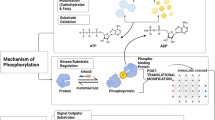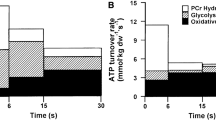Abstract
Sartorius muscle fibres from cold-adapted Rana temporaria were exposed to variants of an established detubulation procedure (Koutsis et al. (1995) J Muscle Res Cell Motil 16, 519–528) to test the extent to which detubulation and tubular vacuolation phenomena could be separated using different conditions of osmotic shock. A control procedure was optimised to a 28-min exposure to 400 mM glycerol–Ringer. This was followed by a recovery step involving its replacement by a Ca2+/Mg2+-Ringer solution and steady cooling over 30 min from room temperature (∼18°C) to ∼10°C, followed by the restoration of the normal Ringer solution. This procedure successfully abolished the action potential after-depolarisation component, reflecting a loss of tubular conduction (‘detubulation’) in 74.3 ± 5.9% of the fibres studied. Omitting the cooling during the recovery step sharply reduced the incidence of detubulation. So did omitting either the high-[Ca2+] and/or [Mg2+] in the recovery solutions in test procedures, but to significantly different extents (P < 5%). Yet trapping of fluorescent Sulfhorhodamine B dye in ‘closed’ vacuoles persisted albeit with reduced proportions of fibre volume occupied by vacuoles. Furthermore, the variations in recovery conditions produced similar levels of vacuolation despite smaller vacuole sizes in the cooled fibres (P < 0.05). These findings demonstrate that fibre vacuolation and detubulation are phenomena that are potentially separable through varying the conditions of osmotic shock, with detubulation requiring significantly more stringent conditions than vacuolation.
Similar content being viewed by others
References
Adrian RH (1956) The effect of internal and external potassium concentration on the membrane potential of frog muscle. J Physiol 133: 631-658.
Adrian RH and Peachey LD (1973) Reconstruction of the action potential of frog sartorius muscle. J Physiol 235: 103-131.
Devlin CM, Chawla S, Skepper JN and Huang CL-H (2001) Persistent tubular conduction in vacuolated amphibian skeletal muscle following osmotic shock. J Muscle Res Cell Motil 22: 459-466.
Endo M (1966) Entry of fluorescent dyes into the sarcotubular system of the frog muscle. J Physiol 185: 224-238.
Franzini-Armstrong C, Heuser JE, Reese TS, Somlyo AP and Somlyo AV (1978) T-tubule swelling in hypertonic solutions: a freeze substitution study. J Physiol 283: 133-146.
Franzini-Armstrong C, Venosa RA and Horowicz P (1973) Morphology and accessibility of the 'transverse' tubular system in frog sartorius muscle after glycerol treatment. J Membr Biol 14: 197-212.
Fraser JA, Skepper JN, Hockaday AR and Huang CL-H (1998) The tubular vacuolation process in amphibian skeletal muscle. J Muscle Res Cell Motil 19: 613-629.
Gage PW and Eisenberg RS (1969a) Capacitance of the surface and transverse tubular membrane of frog sartorius muscle fibres. J Gen Physiol 53: 265-278.
Gage PW and Eisenberg RS (1969b) Action potentials, afterpotentials and excitation-contraction coupling in frog sartorius fibers without transverse tubules. J Gen Physiol 53: 298-310.
Gallagher FA and Huang CL-H (1997) Osmotic 'detubulation' in frog muscle arises from a reversible vacuolation process. J Muscle Res Cell Motil 18: 305-322.
Gonzalez-Serratos H (1971) Inward spread of activation in vertebrate muscle fibres. J Physiol 212: 777-799.
Griffths G (1993) Quantitative aspects of immunocytochemistry. In: Fine Structure Immunocytochemistry. (Chap 11) Springer-Verlag, Berlin Heidelberg.
Howell JN (1969) A lesion of the transverse tubules of skeletal muscle. J Physiol 201: 515-533.
Huang CL-H and Peachey LD (1989) Anatomical distribution of voltage-dependent membrane capacitance in frog skeletal muscle fibres. J Gen Physiol 93: 565-584.
Huang CL-H and Peachey LD (1992) A reconstruction of charge movement during the action potential in frog skeletal muscle. Biophys J 61: 1133-1146.
Khan KN, Skepper JN, Hockaday AR, Burgess AJ and Huang CL-H (2000) Loop diuretics inhibit detubulation and vacuolation in amphibian muscle fibres exposed to osmotic shock. J Muscle Res Cell Motil 21: 79-90.
Koutsis G, Philippides A and Huang CL-H (1995) The afterdepolarisation in Rana temporaria muscle fibres following osmotic shock. J Muscle Res Cell Motil 16: 519-528.
Krolenko SA (1971) Effect of fluxes of sugars and mineral ions on the light microscopic structure of frog fast muscle fibres. Nature 229: 424-426.
Krolenko SA and Lucy JA (2001) Reversible vacuolation of T-tubules in skeletal muscle: mechanisms and implications for cell biology. Int Rev Cytol 202: 243-298.
Krolenko SA, Adamyan SY and Lucy JA (1997) Functional role of vacuolation in the T-system of skeletal muscle. Tsitologiya 39: 878-888.
Krolenko SA, Amos WB and Lucy JA (1995) Reversible vacuolation of the transverse tubules of frog skeletal muscle: a confocal fluorescence microscopy study. J Muscle Res Cell Motil 16: 401-411.
Lannergren J and Westerblad H (1987) Action potential fatigue in single skeletal fibres of Xenopus. Acta Physiol Scand 129: 311-318.
Lannergren J, Bruton J and Westerblad H (1999) Vacuole formation in fatigued single muscle fibres from frog and mouse. J Muscle Res Cell Motil 20: 19-32.
Nik-Zainal S, Skepper JN, Hockaday A and Huang CL-H (1999) Cardiac glycosides inhibit detubulation in amphibian skeletal muscle fibres exposed to osmotic shock. J Muscle Res Cell Motil 20: 45-53.
Padmanabhan N and Huang CL-H (1990) Separation of tubular electrical activity in amphibian skeletal muscle through temperature change. Exp Physiol 75: 721-724.
Sheikh SM, Skepper JN, Chawla S, Vandenberg JI, Elneil S and Huang CL-H (2001) Normal conduction of surface action potentials in detubulated amphibian skeletal muscle fibres. J Physiol 535: 579-590.
Weibel ER (1997) Stereological Methods. (Vol 1) In: (eds) Practical Methods for Biological Morphometry. Academic Press, London.
Zachar J, Zacharova D and Adrian RH (1972) Observations on 'detubulated' muscle fibres. Nature New Biol 239: 153-155.
Author information
Authors and Affiliations
Rights and permissions
About this article
Cite this article
Cooper, S.J., Chawla, S., Fraser, J.A. et al. Separation of detubulation and vacuolation phenomena in amphibian skeletal muscle. J Muscle Res Cell Motil 23, 327–333 (2002). https://doi.org/10.1023/A:1022019131898
Issue Date:
DOI: https://doi.org/10.1023/A:1022019131898




